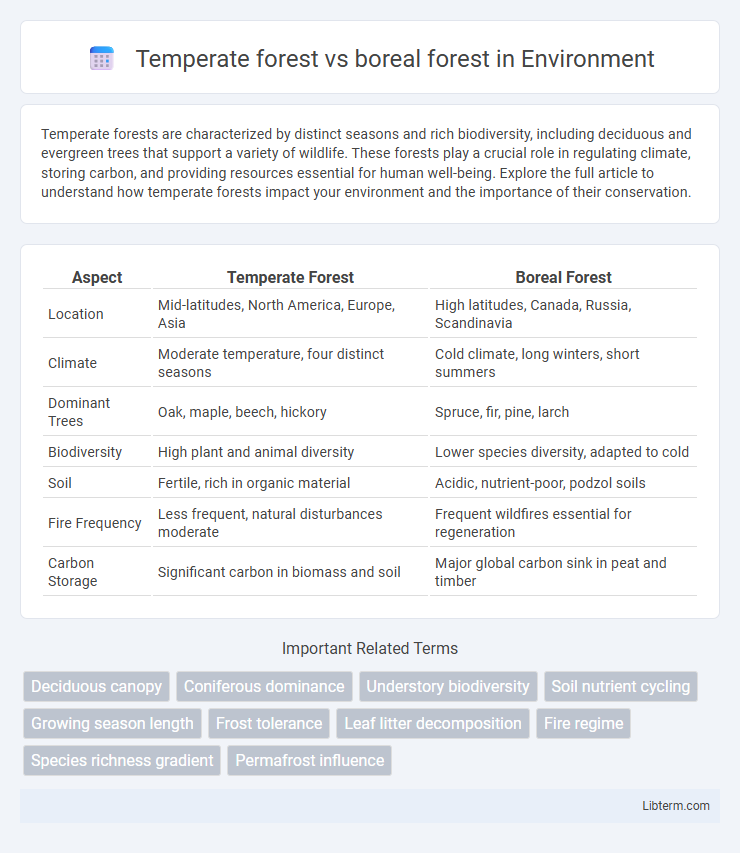Temperate forests are characterized by distinct seasons and rich biodiversity, including deciduous and evergreen trees that support a variety of wildlife. These forests play a crucial role in regulating climate, storing carbon, and providing resources essential for human well-being. Explore the full article to understand how temperate forests impact your environment and the importance of their conservation.
Table of Comparison
| Aspect | Temperate Forest | Boreal Forest |
|---|---|---|
| Location | Mid-latitudes, North America, Europe, Asia | High latitudes, Canada, Russia, Scandinavia |
| Climate | Moderate temperature, four distinct seasons | Cold climate, long winters, short summers |
| Dominant Trees | Oak, maple, beech, hickory | Spruce, fir, pine, larch |
| Biodiversity | High plant and animal diversity | Lower species diversity, adapted to cold |
| Soil | Fertile, rich in organic material | Acidic, nutrient-poor, podzol soils |
| Fire Frequency | Less frequent, natural disturbances moderate | Frequent wildfires essential for regeneration |
| Carbon Storage | Significant carbon in biomass and soil | Major global carbon sink in peat and timber |
Introduction to Temperate and Boreal Forests
Temperate forests, characterized by moderate climate and distinct seasons, host diverse tree species like oaks, maples, and beeches, supporting rich biodiversity and complex ecosystems. Boreal forests, also known as taiga, dominate the northern hemisphere with coniferous trees such as spruces, pines, and firs, adapted to cold climates and long winters. These forest types play crucial roles in carbon storage, climate regulation, and habitat provision across vast geographical areas.
Geographic Distribution and Climate
Temperate forests are primarily located in eastern North America, Europe, and parts of East Asia, characterized by moderate climates with distinct seasons and ample rainfall ranging from 750 to 1,500 millimeters annually. Boreal forests, also known as taiga, occupy vast regions across Canada, Russia, and Scandinavia, experiencing long, harsh winters with temperatures often below -30degC and short, mild summers, with annual precipitation typically between 200 and 600 millimeters. The geographic distribution of temperate forests corresponds to mid-latitude regions with fertile soil, while boreal forests dominate high-latitude areas with acidic, nutrient-poor soils shaped by permafrost and cold climate conditions.
Key Tree Species in Each Forest Type
Temperate forests are dominated by broadleaf species such as oak (Quercus), maple (Acer), and beech (Fagus), alongside conifers like Douglas fir (Pseudotsuga menziesii) and pine (Pinus). Boreal forests primarily consist of coniferous trees, with dominant species including black spruce (Picea mariana), white spruce (Picea glauca), balsam fir (Abies balsamea), and jack pine (Pinus banksiana). These key species reflect adaptations to differing climates, with temperate trees favoring more nutrient-rich soils and moderate temperatures, while boreal species are adapted to colder, nutrient-poor conditions.
Soil Composition and Characteristics
Temperate forest soils are typically rich in organic matter and nutrients, with well-developed horizons that support diverse plant life, often displaying a loamy texture and moderate acidity. Boreal forest soils, known as podzols, are acidic and nutrient-poor due to slow decomposition rates and accumulation of organic layers like humus and mor, leading to less fertile conditions. The thicker organic layers in boreal forests result from colder temperatures and coniferous litter, contrasting with the more balanced mineral and organic content found in temperate forest soils.
Wildlife Diversity and Adaptations
Temperate forests host a higher wildlife diversity with species such as deer, black bears, and songbirds, adapting through seasonal behaviors like migration and hibernation. Boreal forests feature species like moose, lynx, and conifer-specialized birds adapted to extreme cold, with thick fur and insulating feathers. Both ecosystems demonstrate unique adaptations enabling survival in their distinct climates and resource availability.
Seasonal Changes and Weather Patterns
Temperate forests experience four distinct seasons, with warm summers and cold winters, resulting in significant variations in temperature and precipitation that support diverse plant and animal life. Boreal forests, or taiga, endure long, harsh winters with temperatures often below freezing and short, mild summers, leading to a limited growing season and dominance of coniferous trees adapted to cold conditions. Seasonal changes in temperate forests drive vibrant foliage and dynamic ecosystems, while boreal forests exhibit more stable but severe weather patterns influencing slower ecological processes.
Ecosystem Services Provided
Temperate forests provide critical ecosystem services such as carbon sequestration, water filtration, and habitat for diverse plant and animal species, supporting biodiversity and local economies through timber and recreation. Boreal forests, covering vast northern regions, play a key role in global carbon storage due to their dense tree biomass and peatlands, while regulating climate and supporting species adapted to colder climates. Both forest types contribute to air purification, soil stabilization, and nutrient cycling, vital for maintaining ecological balance and human well-being.
Human Impact and Land Use
Temperate forests experience significant human impact through urbanization, agriculture, and logging, resulting in habitat fragmentation and biodiversity loss. Boreal forests face large-scale disturbances primarily from commercial logging and mining, which alter carbon storage and disrupt indigenous communities. Both forest types are affected by climate change, exacerbating land use pressures and threatening ecosystem stability.
Conservation Challenges and Efforts
Temperate forests face conservation challenges such as habitat fragmentation, invasive species, and urban development, prompting efforts like reforestation, sustainable logging practices, and protected area designation. Boreal forests experience threats from logging, mining, and climate change-induced wildfires, leading to conservation strategies emphasizing fire management, Indigenous land stewardship, and carbon sequestration projects. Both ecosystems require coordinated global policies to balance economic interests with biodiversity preservation and climate resilience.
Future Outlook for Temperate and Boreal Forests
Temperate forests face challenges from climate change and deforestation, but increased conservation efforts and sustainable management practices offer a promising future by promoting biodiversity and carbon sequestration. Boreal forests are expected to experience shifts in species composition and increased fire frequency due to rising temperatures, potentially reducing their carbon storage capacity and altering global climate feedback loops. Both forest types are critical for mitigating climate change, requiring adaptive strategies to balance ecological resilience and human demands.
Temperate forest Infographic

 libterm.com
libterm.com